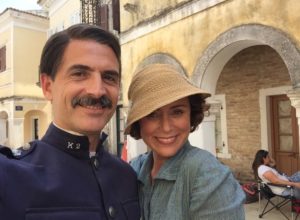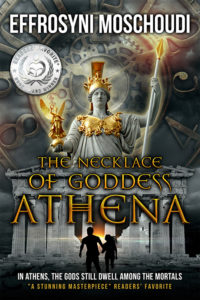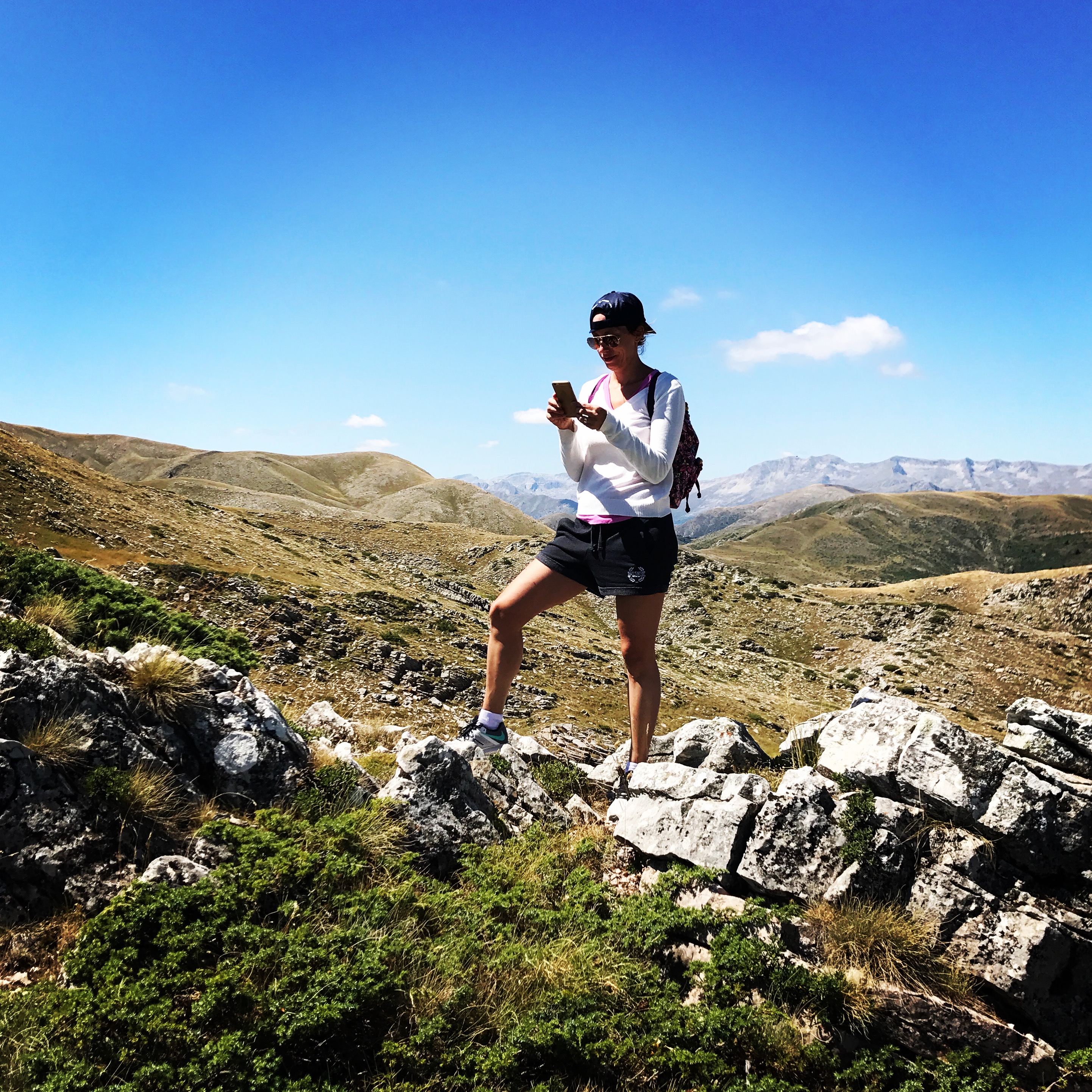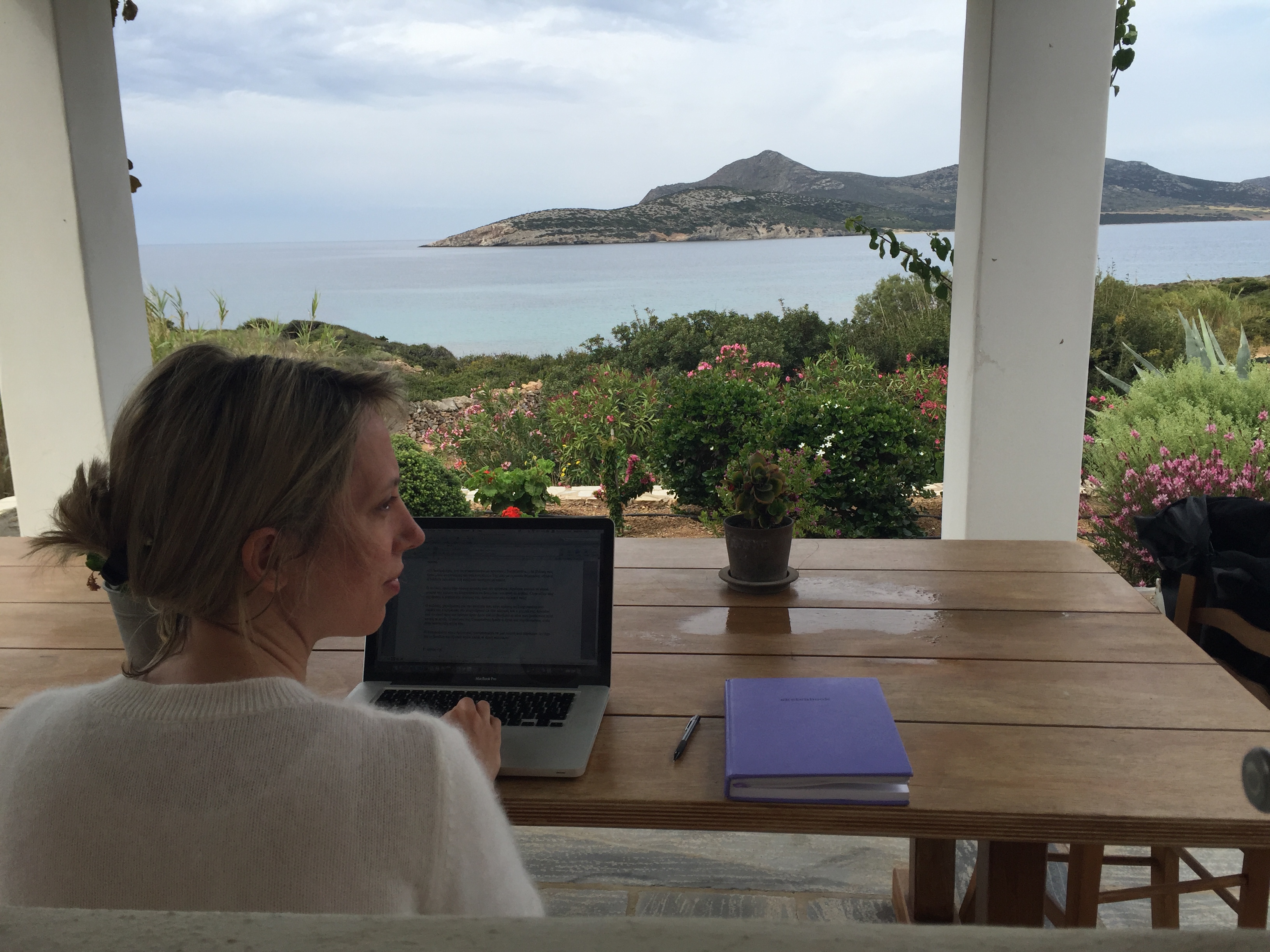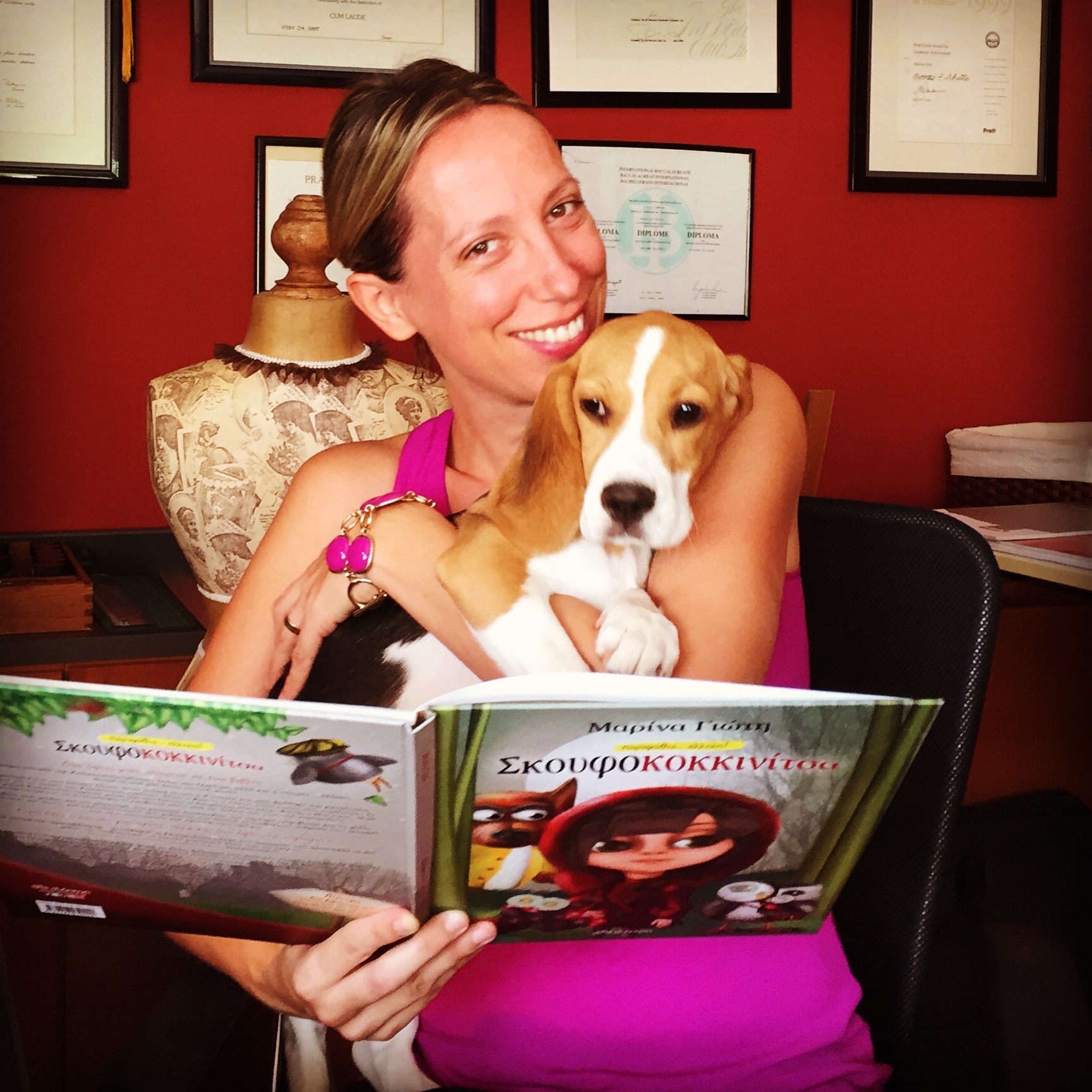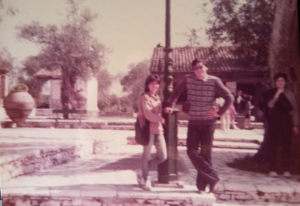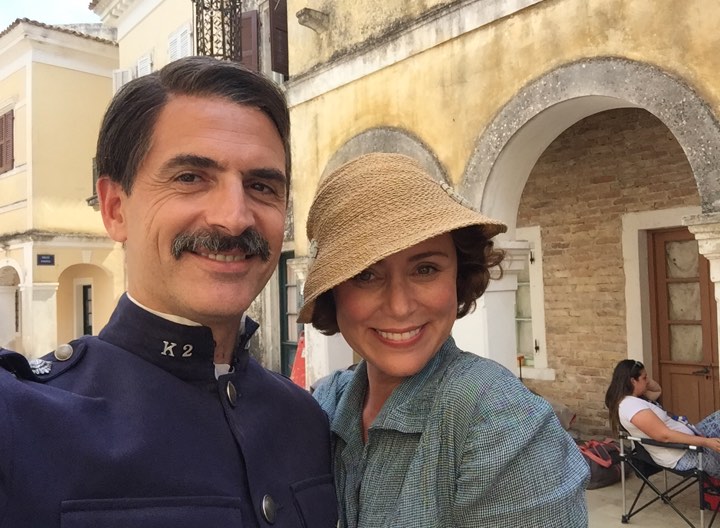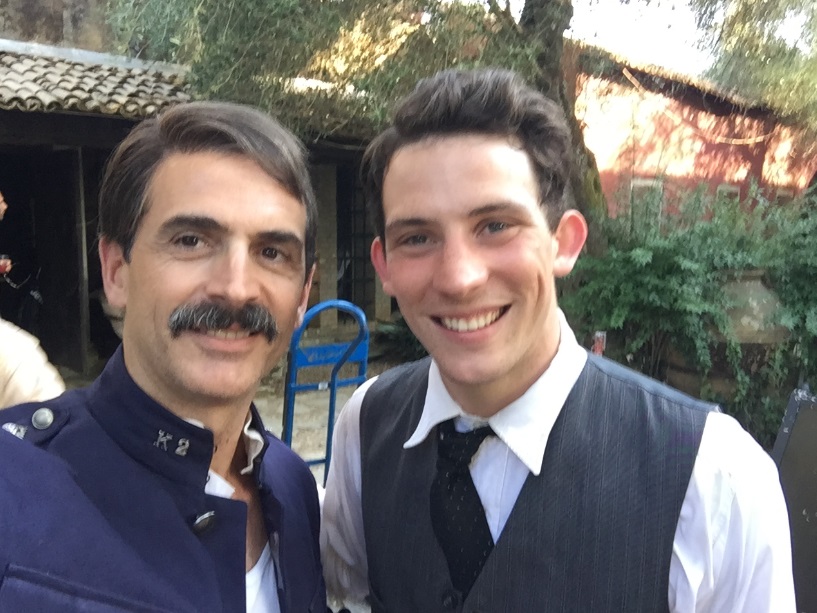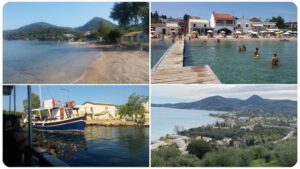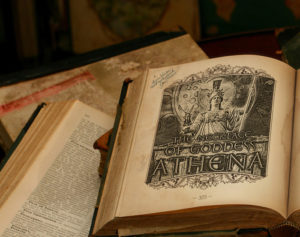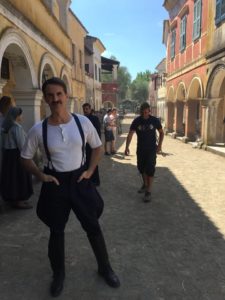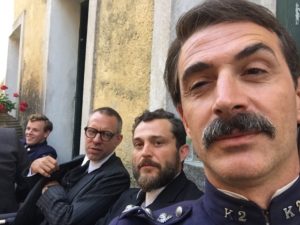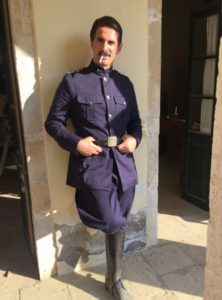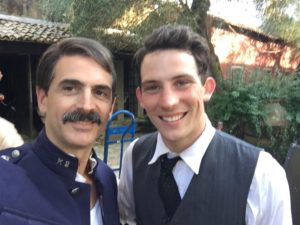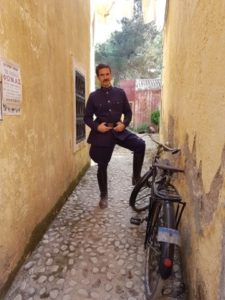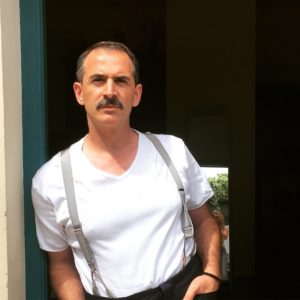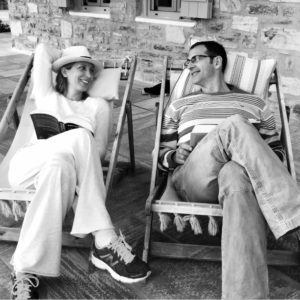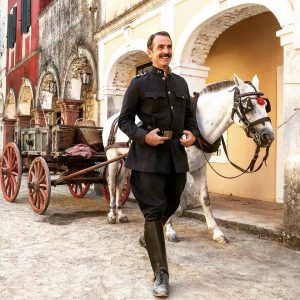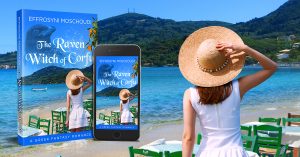
Hello folks! Today I’m honored to have on my blog the talented children’s author and illustrator, Marina Gioti. Those who follow my blog may remember I mentioned her during my recent interview with her husband, fabulous author (and actor of The Durrells) Kostas Krommydas.
Marina enjoys tremendous success in Greece. The photos from her book tours that she brought to show us today attest to that fact. Her books have recently been translated into English and made available on Amazon so readers around the world can sample her exquisite stories and illustrations too. It’s a thrill for me to introduce Marina’s work to you today. Check this out:

There are two sides to every story. Little Red Riding Hood retold, both as you know it and…as you don’t! What really happened in the woods? Who was the mysterious Mr. Huntsman and how did he happen to be at the right place at the right time? Was the Big Bad Wolf really big and truly bad? Why was Little Red Riding Hood alone in the woods in the first place? Intrepid reporter Tom Flibbertigibbet is ready to read between the lines and uncover the truth behind this classic fairy tale. A book about the hidden racism in classic fairytales, school bullying, and friendship…
READ MORE ON AMAZON US UK

There are two sides to every story. Cinderella retold, both as you know it and…as you don’t! Was the Prince as charming as he appeared? Does this fairy tale sound too much like a tall tale? Who was the Fairy Godmother and what part did she really play in the story? What happens after happily-ever-after? Having solved the mystery of Little Red Riding Hood in the first, bestselling, Twice Upon a Time, Tom Flibbertigibbet is back, determined to read between the lines of this classic fairy tale. This is a book about the magic that is love, the strength of willpower, and chasing the impossible…
READ MORE ON AMAZON US UK

There are two sides to every story. Little Thumb retold, both as you know it and…as you don’t! How could parents abandon their children in the forest? And how likely is it that smart Little Thumb did not know that the crumbs would not last for long in the woods? Besides, if he was so short, how did the huge Giant manage to see him and… not step on him? And really, now, just how tired was this Giant to let Little Thumb steal his boots? Once again, intrepid reporter Tom Flibbertigibbet is determined to unearth the truth behind the classic fairy tale. A book about sibling cooperation, achieving adulthood, and facing our worst fears…
Grab it! Only $1.99 for a limited time!
READ MORE ON AMAZON US UK
Hello Marina and welcome to my blog!
Thank you for inviting me, Fros! Thrilled to be here.
What has inspired you to write the “Twice Upon a Time” children’s book series?
It was a phrase that my daughter, Vaia, used to describe a fox when she was just five years old. She said: “Mummy, a cunning fox!” and I thought, “Why cunning?” Are all foxes cunning and all wolves bad? Why so much discrimination in children’s fairytales? That’s how the idea of “Twice Upon a Time: Little Red Riding Hood” was born. In the book series, we start with the classic fairytale for younger children, and we continue after “happily ever after” when the child is ready to question the original story.
Oh how fresh! I love this concept…
Thank you, Fros. And what’s more, each book has a theme: “Twice Upon a Time: Little Red Riding Hood” is about racism and bulling, “Twice Upon a Time: Cinderella” questions the idea of the perfect prince and shows children that the magic we need to make a difference is within us. “Twice Upon a Time: Little Thumb” helps children face their fears. All three books teach children to question what they hear or take for granted and to think critically.
Wonderful! What other writing have you done? Anything else published?
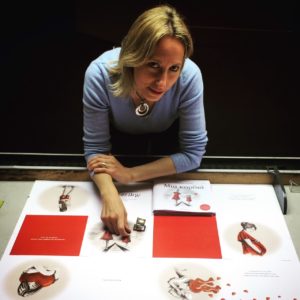
I have authored six picture books in Greek, three of which have been translated into English and are now available on Amazon. A book I am very proud of is called “One Heart”. It is a picture book for mothers and daughters of all ages, which explores that never-ending love we have for our children. It was traditionally published in Greece last year and is due to be released in English through Amazon very soon. I have received more feedback for that book in Greece than any other book I have ever authored, and I am eagerly anticipating its release on Amazon to see how it will be received by English-speaking readers.
Any hobbies or interests that you enjoy in your spare time?
I’ve been an avid tennis player since the age of nine. I also ski; either on the mountains or on water depending on the season, and I love to ride my bicycle too. I also read a lot and go to the theater very often.
Wow, where do you find the time? I am astounded!
Yes, finding time for fun is always a problem but I manage somehow! *giggles*
Who are your favorite authors, and what do you love about them?
Difficult question, I have so many! Children’s book authors: I love the work of Kobi Yamada and Oliver Jeffers. Novels I have enjoyed include the “Tea Rose” trilogy by Jennifer Donnely and the “The Nightingale” by Kristin Hannah.
What genres do you read mostly, and what are you reading now?

Marina in an event of Public stores with her husband Kostas Krommydas and Greek author Lena Manda
I read and collect children’s books for all age groups. I am a big fan of Harry Potter. I also read crime fiction, mystery romance novels, and biographies.
My readers (and I) love pets! Do you have any? Tell us their names, and share any photos please!
Ever since I remember myself I’ve had pets, mostly dogs; I’ve also adopted a couple of cats in the past. I prefer to adopt rather than buy a pet. I believe that the right dog finds you in a karmic kind of way, when it is time.
Oh that’s so true. And do you have any pets at the moment?
Yes, I have Cora – a female beagle, and I adore her… She is my buddy and we usually work together. I tend to talk to her a lot sharing my ideas. She looks at me in a way that often suggests I am crazy, but that’s okay. She doesn’t share that information with anybody, though…
Good girl, Cora! *chortles* Are there any sites or writing tools that you find useful and wish to recommend?
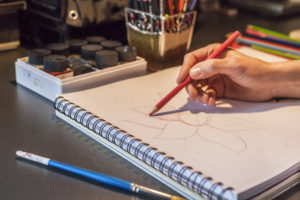
I studied illustration and communication design in a prominent art school in New York. When I returned to Greece, I worked for fifteen years in advertising, where I rarely used my illustration skills. When a well-known traditional publishing house in Greece approved my first book for publication, I asked them to collect some samples before hiring an illustrator, while I submitted my own work for consideration too. The site that helped me the most to do that was what later became SVS (Society of Visual Storytelling) by Will Terry and his team. The site is filled with amazing tips and videos! They helped me update my skills in digital media and to improve my craft so I could become the illustrator of my own published books. I am very, very grateful!
I am so glad you could do that, Marina. It benefits the children too, I believe, to be able to see how the characters actually look in the author’s mind. And thank you for this precious resource for illustrators! If you could have one superpower what would it be?
To be able to manipulate time. I always think its not enough!
Oh, I feel you! What are the things in your life that you’re most grateful for?
-

-
Marina and her daughter on holiday in Paris and Eurodisney
-


Marina Gioti and her husband, author and actor Kostas Krommydas
My family, my wild imagination and my strong empathy.
How would you like to be remembered?
As a storyteller that helped children dream without restrictions so they could make their dreams come true as adults.
And that would be a wonderful legacy… I wish it for you, Marina. Thank you so much for being here with us today!
Thank you too, Fros, for introducing me to your readers. I enjoyed our chat immensely!
BIO

Children’s books and art are Marina Gioti’s twin passions; passions that have found their perfect expression in her best-selling children’s books. Born in Athens, Greece, Marina studied Marketing and Fine Arts at Georgetown University in Washington, D.C. followed by Communication Design and Illustration at Pratt Institute in N.Y. She is the 1999 recipient of the John Peter’s Publication Award and Scholarship from the N.Y. Art Directors Club and has won a Bronze Pentaward for her work in design. Her third book, “Twice upon a time – Little Red Riding Hood,” was voted as one of the 10 best picture books in her native Greece (2016).
Marina spends her time between Greece and the UK, writing, illustrating and giving book presentations to children and parents. She is a regular contributor to popular magazines and websites, and a member of the Greek Section of the International Board on Books for Young People (IBBY).
Visit Marina’s Amazon page on US UK
SPREAD THE WORD WITH A TWEET:

Did you enjoy this post? Type your email in the ‘follow this blog’ window on the right sidebar and get to see all our future posts!

To grab “Facets of Love” for FREE, go here! Planning to visit Greece? Check out our FREE guide to Corfu! For delicious Greek recipes, go here. Are you an author? Check out our FREE promo tips & resources here.






